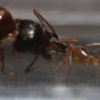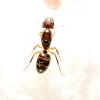- Formiculture.com
- Forums
- Gallery
- Members
- Member Map
- Chat

Are tetramorium sp e polygynous?
Started By
WealthyCow
, Jul 6 2017 8:27 AM
21 replies to this topic
#1
 Offline
-
Posted July 6 2017 - 8:27 AM
Offline
-
Posted July 6 2017 - 8:27 AM
I recently caught about 20 queens during a nuptial flight, would it be worthwhile to put more than one queen per test tube? If so, how many (2,3,4 etc.)?
#2
 Offline
-
Posted July 6 2017 - 8:51 AM
Offline
-
Posted July 6 2017 - 8:51 AM
I put 15 in one test tube just yesteday. We'll see how it goes.
“If I am killed for simply living, let death be kinder than man.” -Althea Davis
#3
 Offline
-
Posted July 6 2017 - 9:01 AM
Offline
-
Posted July 6 2017 - 9:01 AM
%survival(20/how many containers you've got)+%survival(20-#/1 super container). Report back to us.
I ran into this issue last year and made a couple mega jars. The test tube colony that I forgot about in the drawer is my current colony if that speaks to what's gonna happen.

"I'm the search bar! Type questions into me and I'll search within the forums for an answer!"
#4
 Offline
-
Posted July 6 2017 - 10:00 AM
Offline
-
Posted July 6 2017 - 10:00 AM
So they are polygynous? XD
I'll try one with 4,3,2 and a bunch of 1's.
I'll try one with 4,3,2 and a bunch of 1's.
#5
 Offline
-
Posted July 6 2017 - 10:45 AM
Offline
-
Posted July 6 2017 - 10:45 AM
Not really... All those in the mega jar died. This was entirely based on me doing absolutely nothing for them. Provided moisture and dirt, but that was it. Those that were in smaller 3-pod groups did their thing. Each made a chamber and continued to grow until it was discovered another was in the mix. I found queen pieces all the time. Tetramorium are what I call "jerk ants" because they are jerks.

"I'm the search bar! Type questions into me and I'll search within the forums for an answer!"
#6
 Offline
-
Posted July 6 2017 - 11:09 AM
Offline
-
Posted July 6 2017 - 11:09 AM
Tetramorium sp. e are pleometrotic. The queens will found together, and subsequently have more nanitics because of it. But shortly after the queens get thier nanitics, they will kill each other until only one queen is left.
Edited by Mdrogun, July 6 2017 - 11:10 AM.
- sgheaton likes this
Currently Keeping:
Trachymyrmex septentrionalis
Pheidole pilifera
Forelius sp. (Monogynous, bicolored) "Midwestern Forelius"
Crematogaster cerasi
Pheidole bicarinata
Aphaenogaster rudis
Camponotus chromaiodes
Formica sp. (microgena species)
Nylanderia cf. arenivega
#7
 Offline
-
Posted July 6 2017 - 11:27 AM
Offline
-
Posted July 6 2017 - 11:27 AM
Aw my dreams of a multi-queen colony  .
.
Know of any polygynous species in Canada (Ontario)? If there are, are they easy to catch?
Know of any polygynous species in Canada (Ontario)? If there are, are they easy to catch?
#8
 Offline
-
Posted July 6 2017 - 12:01 PM
Offline
-
Posted July 6 2017 - 12:01 PM
This has been discussed previously, recently, and in this subforum.
Polygyny has been documented in wild colonies of Tetramorium cf. caespitum / spE. I've also seen notes from keepers online that one or all queens are eventually killed when reared this way, but I've seen other notes to the contrary. It has been speculated, and there is some evidence, that Tetramorium caespitum is a complex of identical species. It could be that polygynous behavior is associated with certain species within this complex or under certain environmental conditions.
I've kept up to 10 Tetramorium queens together during the founding stage and separated them after workers eclosed without any issues when I was low on space. You may be able to keep a couple together in a single colony, and it may be interesting for you to know how they behave in your area. That said, if you want to go that route and see what happens, plan on keeping some monogyne colonies, otherwise you may lose your opportunity to rear Tetramorium this year.
Edited by Cameron C. Thomas, July 6 2017 - 12:03 PM.
- Nathant2131 likes this
#9
 Offline
-
Posted July 6 2017 - 12:23 PM
Offline
-
Posted July 6 2017 - 12:23 PM
Myrmica sp, Brachymyrmex, Stenamma, Temnothorax sp. Leptothorax and basically all of the small onesAw my dreams of a multi-queen colony
.
Know of any polygynous species in Canada (Ontario)? If there are, are they easy to catch?
Very easy to catch with a blacklight or just wandering around
Edited by Canadian anter, July 6 2017 - 12:23 PM.
Visit us at www.canada-ant-colony.com !
#10
 Offline
-
Posted July 6 2017 - 12:24 PM
Offline
-
Posted July 6 2017 - 12:24 PM
Solenopsis Molesta are polygnous and as tiny as can be. Not sure if they are in Canada or not.

"I'm the search bar! Type questions into me and I'll search within the forums for an answer!"
#11
 Offline
-
Posted July 6 2017 - 12:28 PM
Offline
-
Posted July 6 2017 - 12:28 PM
Myrmica sp, Brachymyrmex, Stenamma, Temnothorax sp. Leptothorax and basically all of the small onesAw my dreams of a multi-queen colony
.
Know of any polygynous species in Canada (Ontario)? If there are, are they easy to catch?
Very easy to catch with a blacklight or just wandering around
Temnothorax here in New England started flying a few days ago, but once seen once so far. Definitely a chance at catching those this season. Super easy at night to find attracted to lighting, even LEDs.
#12
 Offline
-
Posted July 6 2017 - 1:16 PM
Offline
-
Posted July 6 2017 - 1:16 PM
This has been discussed previously, recently, and in this subforum.
Polygyny has been documented in wild colonies of Tetramorium cf. caespitum / spE. I've also seen notes from keepers online that one or all queens are eventually killed when reared this way, but I've seen other notes to the contrary. It has been speculated, and there is some evidence, that Tetramorium caespitum is a complex of identical species. It could be that polygynous behavior is associated with certain species within this complex or under certain environmental conditions.
I've kept up to 10 Tetramorium queens together during the founding stage and separated them after workers eclosed without any issues when I was low on space. You may be able to keep a couple together in a single colony, and it may be interesting for you to know how they behave in your area. That said, if you want to go that route and see what happens, plan on keeping some monogyne colonies, otherwise you may lose your opportunity to rear Tetramorium this year.
Isn't Tetramorium tsushimae polygynous? quite possible people are misidentifying them as sp. e or caespitum, then being surprised when they have a polygyne colony.
Edited by Mdrogun, July 6 2017 - 1:30 PM.
Currently Keeping:
Trachymyrmex septentrionalis
Pheidole pilifera
Forelius sp. (Monogynous, bicolored) "Midwestern Forelius"
Crematogaster cerasi
Pheidole bicarinata
Aphaenogaster rudis
Camponotus chromaiodes
Formica sp. (microgena species)
Nylanderia cf. arenivega
#13
 Offline
-
Posted July 6 2017 - 1:53 PM
Offline
-
Posted July 6 2017 - 1:53 PM
This has been discussed previously, recently, and in this subforum.
Polygyny has been documented in wild colonies of Tetramorium cf. caespitum / spE. I've also seen notes from keepers online that one or all queens are eventually killed when reared this way, but I've seen other notes to the contrary. It has been speculated, and there is some evidence, that Tetramorium caespitum is a complex of identical species. It could be that polygynous behavior is associated with certain species within this complex or under certain environmental conditions.
I've kept up to 10 Tetramorium queens together during the founding stage and separated them after workers eclosed without any issues when I was low on space. You may be able to keep a couple together in a single colony, and it may be interesting for you to know how they behave in your area. That said, if you want to go that route and see what happens, plan on keeping some monogyne colonies, otherwise you may lose your opportunity to rear Tetramorium this year.
Isn't Tetramorium tsushimae polygynous? quite possible people are misidentifying them as sp. e or caespitum, then being surprised when they have a polygyne colony.
Yes, T. tsushimae is polygynous, but it's not a species with which I'm very familiar. I know it occurs here and there, but most people should be finding T. cf. caespitum / spE. The first case of polygyny in the literature that I'm aware of is from 2003.
Steiner FM, Schlick-Steiner BC, Buschinger A (2003) First record of unicolonial polygyny in Tetramorium cf. caespitum (Hymenoptera, Formicidae). Insectes Sociaux 1:98-99.
The first and second authors on that paper were also coauthors on a 2006 paper that found evidence of at least 7 distinct lineages in sampling of the palearctic T. caespitum/impurum complex, and as I mentioned earlier, differences in mating systems could be characteristic of separate species in the complex or environmental conditions.
#14
 Offline
-
Posted July 6 2017 - 2:07 PM
Offline
-
Posted July 6 2017 - 2:07 PM
I'll make a journal for the 15 queens together if anyone is interested. I just want to get them ID'd to be sure they are Tetramorium.
- Bracchymyrmex likes this
“If I am killed for simply living, let death be kinder than man.” -Althea Davis
#15
 Offline
-
Posted July 6 2017 - 2:19 PM
Offline
-
Posted July 6 2017 - 2:19 PM
I'll make a journal for the 15 queens together if anyone is interested. I just want to get them ID'd to be sure they are Tetramorium.
Make the journal. This is gonna be a blood bath.
#16
 Offline
-
Posted July 6 2017 - 2:26 PM
Offline
-
Posted July 6 2017 - 2:26 PM
I'll make a journal for the 15 queens together if anyone is interested. I just want to get them ID'd to be sure they are Tetramorium.
Make the journal. This is gonna be a blood bath.
Perhaps not. My 7 Tetramorium cf. caespitum queens are getting along flawlessly in the same tube. Right now they already have about roughly 50-60 eggs within only 2 days of capture.
http://www.formicult...l-started-7517/
#17
 Offline
-
Posted July 6 2017 - 2:44 PM
Offline
-
Posted July 6 2017 - 2:44 PM
I'll make a journal for the 15 queens together if anyone is interested. I just want to get them ID'd to be sure they are Tetramorium.
Make the journal. This is gonna be a blood bath.
Perhaps not. My 7 Tetramorium cf. caespitum queens are getting along flawlessly in the same tube. Right now they already have about roughly 50-60 eggs within only 2 days of capture.
http://www.formicult...l-started-7517/
Whenever I've housed Tetramorium queens together during the founding stage, I've noticed they tend to oviposit waaay more than when I initially house them separately. You may see that number get even higher.
Edited by Cameron C. Thomas, July 6 2017 - 2:45 PM.
#18
 Offline
-
Posted July 6 2017 - 2:47 PM
Offline
-
Posted July 6 2017 - 2:47 PM
I'll make a journal for the 15 queens together if anyone is interested. I just want to get them ID'd to be sure they are Tetramorium.
Make the journal. This is gonna be a blood bath.
Perhaps not. My 7 Tetramorium cf. caespitum queens are getting along flawlessly in the same tube. Right now they already have about roughly 50-60 eggs within only 2 days of capture.
http://www.formicult...l-started-7517/
Whenever I've housed Tetramorium queens together during the founding stage, I've noticed they tend to oviposit waaay more than when I initially house them separately. You may see that number get even higher.
I wouldn't doubt if it will. The amount of eggs is still rising faster than ever.
#19
 Offline
-
Posted July 6 2017 - 5:15 PM
Offline
-
Posted July 6 2017 - 5:15 PM
This has been discussed previously, recently, and in this subforum.
Polygyny has been documented in wild colonies of Tetramorium cf. caespitum / spE. I've also seen notes from keepers online that one or all queens are eventually killed when reared this way, but I've seen other notes to the contrary. It has been speculated, and there is some evidence, that Tetramorium caespitum is a complex of identical species. It could be that polygynous behavior is associated with certain species within this complex or under certain environmental conditions.
I've kept up to 10 Tetramorium queens together during the founding stage and separated them after workers eclosed without any issues when I was low on space. You may be able to keep a couple together in a single colony, and it may be interesting for you to know how they behave in your area. That said, if you want to go that route and see what happens, plan on keeping some monogyne colonies, otherwise you may lose your opportunity to rear Tetramorium this year.
Isn't Tetramorium tsushimae polygynous? quite possible people are misidentifying them as sp. e or caespitum, then being surprised when they have a polygyne colony.
Yes, T. tsushimae is polygynous, but it's not a species with which I'm very familiar. I know it occurs here and there, but most people should be finding T. cf. caespitum / spE. The first case of polygyny in the literature that I'm aware of is from 2003.
Steiner FM, Schlick-Steiner BC, Buschinger A (2003) First record of unicolonial polygyny in Tetramorium cf. caespitum (Hymenoptera, Formicidae). Insectes Sociaux 1:98-99.
The first and second authors on that paper were also coauthors on a 2006 paper that found evidence of at least 7 distinct lineages in sampling of the palearctic T. caespitum/impurum complex, and as I mentioned earlier, differences in mating systems could be characteristic of separate species in the complex or environmental conditions.
My understanding is that T. Caespitum is actually a species complex in Europe and that T. sp E is the specific species that took root in North America. I don't know if that's completely accurate, but I've read it a few times in some credible sounding forum posts. If that is true, then we would presumably see more uniform behavior in North American colonies than their European counterparts.
#20
 Offline
-
Posted July 7 2017 - 7:32 AM
Offline
-
Posted July 7 2017 - 7:32 AM
I didn't see the post from before, sorry for the repost.
0 user(s) are reading this topic
0 members, 0 guests, 0 anonymous users





















